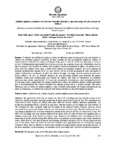Please use this identifier to cite or link to this item:
http://www.alice.cnptia.embrapa.br/alice/handle/doc/914249| Title: | Atributos químicos restritivos de latossolo vermelho distrófico e tipos de manejo de solo e rotação de culturas. |
| Authors: | SPERA, S. T.  ESCOSTEGUY, P. A. V.   DENARDIN, J. E.   KLEIN, V. A.   SANTOS, H. P. dos   |
| Affiliation: | SILVIO TULIO SPERA, CPAMT; PEDRO ALEXANDRE VARELLA ESCOSTEGUY, UPF; JOSE ELOIR DENARDIN, CNPT; VILSON ANTÔNIO KLEIN, UPF; HENRIQUE PEREIRA DOS SANTOS, CNPT. |
| Date Issued: | 2011 |
| Citation: | Agrarian, Dourados, v. 4. n. 14, p.324-334, 2011. |
| Description: | Resumo. O objetivo do trabalho foi avaliar os efeitos de diferentes tipos de manejo de solo e de rotações de culturas nos atributos químicos restritivos de duas camadas de solo na produção vegetal de culturas. O experimento foi conduzido em campo, na Embrapa Trigo, após 22 anos de cultivo sem aplicação de calcário, no solo. O delineamento experimental foi de blocos ao acaso, em esquema de parcelas subdivididas com três tipos de manejo e três rotações de culturas. Foi avaliado o efeito no rendimento de grãos e na matéria seca da parte aérea das culturas, bem como o efeito destes fatores nos atributos químicos dos solos também foi avaliado em função das camadas de 0 a 6,7 cm e de 6,8 a 20 cm. O efeito do manejo de solo e da rotação de culturas influenciou o rendimento de grãos das culturas de trigo e de sorgo, além da matéria da parte aérea destas culturas e da soja. Os atributos químicos do solo não foram afetados pela interação dos fatores estudados, sendo pouco influenciados pela rotação de culturas. Em todos os tratamentos, os resultados indicaram uma camada superficial (0 a 6,7 cm) com concentração de nutrientes e outra subsuperficial (6,8 a 20 cm) mais ácida e compactada. Na camada superficial os valores dos atributos químicos foram adequados para o desenvolvimento das culturas avaliadas nos manejos plantio direto e preparo mínimo. Não houve diferenças entre os valores de matéria orgânica e entre as frações particuladas. Na camada subsuperficial, em todos os tratamentos, os atributos de acidez do solo foram restritivos ao desenvolvimento de plantas. Abstract. The goal of the work was to evaluate the effects of soil tillage and crop rotation systems in the restrictive chemical attributes and plant production of grain crops of two layers of soil. The experiment was carried out in Passo Fundo, RS, Brazil, after more than two decades without limestone application. The design was randomized blocks, schedule of split plots, with three modes of soil tillage and crop rotations. It was evaluated the effect on grain yield and dry matter of the shoot of winter (Triticum aestivum, Avena sativa and Vicia sativa) and summer (Glycine max and Sorghum bicolor) crops. The effect of these factors in soil chemical attributes has also been evaluated according to the layer of soil (0 to 6.7 and 6.8 to 20 cm). The effects of soil tillage and crop rotation influenced the grain yields of crops of wheat and sorghum only, in addition to the mass of the shoots of soybean crop. Chemical soil attributes were not influenced by the interaction of factors studied, being little influenced by crop rotation. In all treatments, the results indicated a surface layer (0 to 6.7 cm) with a nutrient concentration, and other subsurface (6.8 to 20 cm) compacted and acid. In the surface layer the values of chemicals attributes were appropriated for the developing cropping evaluated. There were no differences between the amounts of organic matter and the particulate fraction. In the layer subsurface, in all treatments, the attributes of the soil acidity were restrictive to plant development. |
| Thesagro: | Manejo do solo Rotação de cultura Latossolo vermelho Acidez do solo Matéria orgânica Plantio direto |
| NAL Thesaurus: | Soil management Crop rotation No-tillage Grain crops Soil pH |
| Type of Material: | Artigo de periódico |
| Access: | openAccess |
| Appears in Collections: | Artigo em periódico indexado (CPAMT)  |
Files in This Item:
| File | Description | Size | Format | |
|---|---|---|---|---|
| 2011AP21.pdf | 242.35 kB | Adobe PDF |  View/Open |









